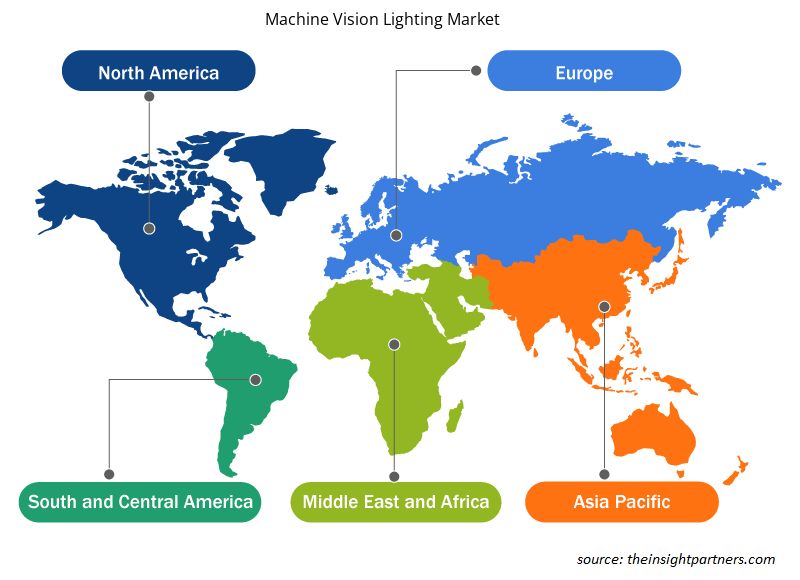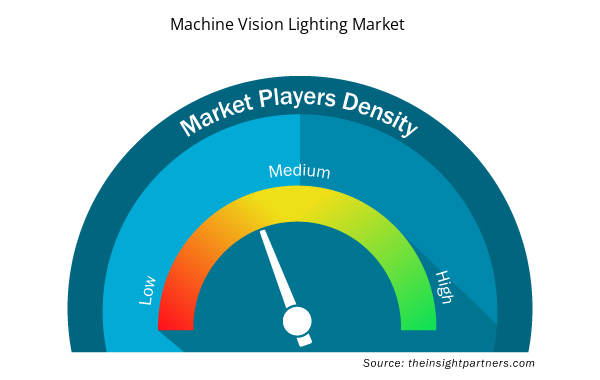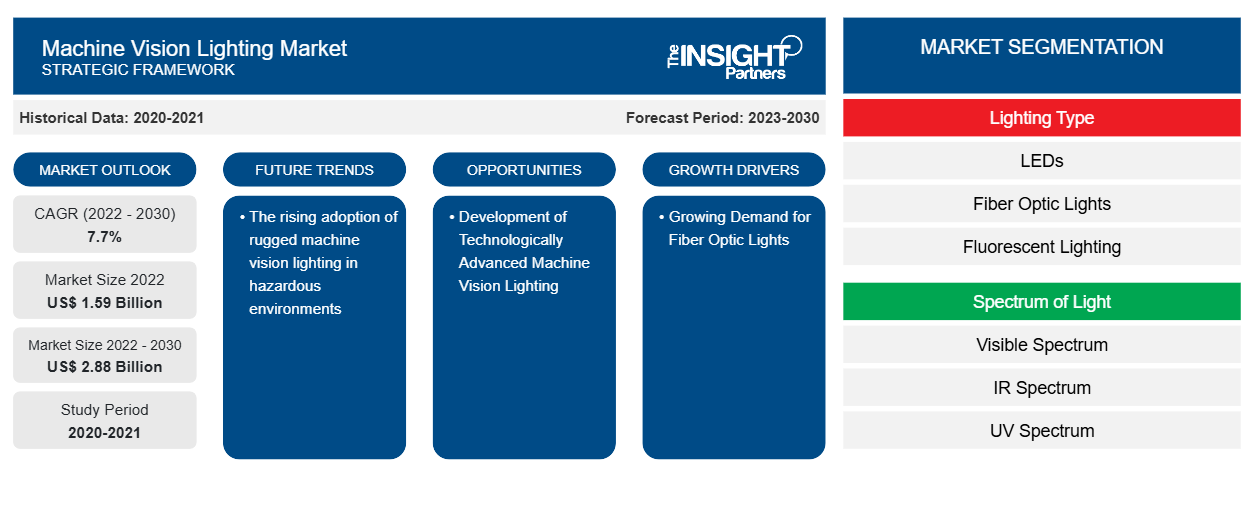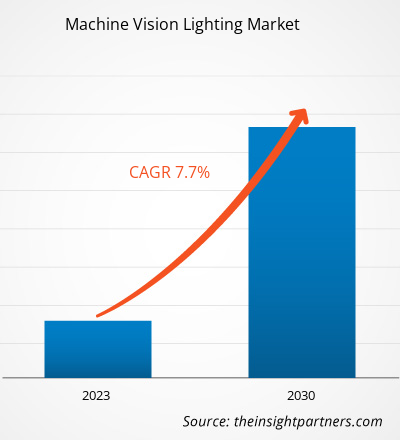Der Markt für Beleuchtungslösungen für industrielle Bildverarbeitung soll von 1,59 Milliarden US-Dollar im Jahr 2022 auf 2,88 Milliarden US-Dollar im Jahr 2030 anwachsen. Der Markt wird im Zeitraum 2022–2030 voraussichtlich eine durchschnittliche jährliche Wachstumsrate von 7,7 % verzeichnen. Der zunehmende Einsatz robuster Beleuchtungslösungen für industrielle Bildverarbeitung in gefährlichen Umgebungen dürfte ein wichtiger Trend auf dem Markt bleiben.
Marktanalyse für Beleuchtung für industrielle Bildverarbeitung
Die wachsende Nachfrage nach Glasfaserleuchten und der wachsende Bedarf an verbesserter Qualität und Produktivität in Herstellungsprozessen treiben den Markt an. Der Markt wird im Prognosezeitraum voraussichtlich aufgrund der zunehmenden Verwendung von Beleuchtung für maschinelles Sehen in gefährlichen Umgebungen stark wachsen. Darüber hinaus schaffen die Entwicklung technologisch fortschrittlicher Beleuchtung für maschinelles Sehen und die wachsende Fertigungsindustrie lukrative Möglichkeiten für den Markt.
Marktübersicht für Beleuchtung für industrielle Bildverarbeitung
Unter Machine Vision-Beleuchtung versteht man die Anwendung spezifischer Beleuchtungstechniken und -geräte im Bereich der maschinellen Bildverarbeitung. Diese Technologie ermöglicht es Maschinen, visuelle Informationen aus ihrer Umgebung zu erfassen und zu interpretieren. Die richtige Beleuchtung in Machine Vision-Anwendungen ist entscheidend für die Verbesserung der Bildqualität und -genauigkeit. Machine Vision-Beleuchtung soll die Beleuchtung von Objekten oder Szenen, die von Machine Vision-Systemen geprüft oder analysiert werden, maximieren. Wesentliche Vorteile der Machine Vision-Beleuchtung, wie Farbgenauigkeit , Kontrast, Beseitigung von Blendung, Kontrast und Rauschreduzierung, beflügeln den Markt.
Passen Sie diesen Bericht Ihren Anforderungen an
Sie erhalten kostenlos individuelle Anpassungen an jedem Bericht, einschließlich Teilen dieses Berichts oder einer Analyse auf Länderebene, eines Excel-Datenpakets sowie tolle Angebote und Rabatte für Start-ups und Universitäten.
- Holen Sie sich die wichtigsten Markttrends aus diesem Bericht.Dieses KOSTENLOSE Beispiel umfasst eine Datenanalyse von Markttrends bis hin zu Schätzungen und Prognosen.
Treiber und Chancen auf dem Markt für Beleuchtung für industrielle Bildverarbeitung
Wachsende Nachfrage nach Glasfaserleuchten begünstigt den Markt
Glasfaserbeleuchtung kann die Lichthomogenität im Sichtfeld maximieren und gleichzeitig die Abweichungen in der Lampenleistung minimieren. Glasfaserbeleuchtung ist für eine Vielzahl von Anwendungen sehr gut geeignet und bietet eine Kombination aus intensivem, fokussiertem (oder gezieltem) und gleichmäßigem Licht. In Kombination mit Filtern können Glasfasern Wellenlängen ausschließen oder verstärken und so die Leistung zur Kontrastkontrolle optimieren oder Hitze vermeiden. Glasfasern können so konstruiert werden, dass sie in extrem kleinen Räumen funktionieren, wenn die Anwendung dies erfordert. Licht kann durch einzelne Fasern mit einer Größe von nur 30 µm übertragen werden. Wenn die Anwendung in einer Umgebung mit hohen Temperaturen stattfindet, können Glasfasern mit einer entfernten Lichtquelle arbeiten. Standard-Glasfaserbeleuchtungssysteme können Umgebungstemperaturen von bis zu 300 °C standhalten.
Entwicklung technologisch fortschrittlicher Beleuchtung für die industrielle Bildverarbeitung
Unternehmen verlangen technologisch fortschrittliche Produkte oder Lösungen, die auch unter rauen Bedingungen reibungslos funktionieren. Smart Vision Lights (SVL), ein Marktführer im Design und in der Herstellung innovativer LED-Beleuchtungslösungen, hat die Leuchte der JWL150-DO Lightgistics-Serie eingeführt, die für raue Umgebungen geeignet ist. Die Leuchte der JWL150-DO Lightgistics-Serie ist mit der Hidden Strobe-Technologie ausgestattet, die die Vorteile des Stroboskoplichts ohne die Ablenkung und Desorientierung bietet, die mit LED-Blitzlichtern verbunden sind. Die Hidden Strobe-Technologie ermöglicht es LEDs, sich tausende Male pro Sekunde selbst auszulösen, schneller zu pulsieren, als das menschliche Auge wahrnehmen kann, und den Anschein einer Dauerbeleuchtung zu erwecken. Die Technologie verbessert Bildverarbeitungssysteme und schützt Mitarbeiter gleichzeitig vor der Verwirrung, die durch blinkende Lichter entsteht.
Segmentierungsanalyse des Marktberichts zur Beleuchtung für maschinelles Sehen
Wichtige Segmente, die zur Ableitung der Marktanalyse für Beleuchtung für industrielle Bildverarbeitung beigetragen haben , sind Beleuchtungsart, Lichtspektrum und Anwendung.
- Basierend auf der Beleuchtungsart ist der Markt für Beleuchtung für die industrielle Bildverarbeitung in LEDs, Glasfaserlampen (Halogen), Leuchtstofflampen, Xenon und andere unterteilt. Das LED-Segment hatte im Jahr 2022 einen größeren Marktanteil.
- Nach Lichtspektrum ist der Markt in sichtbares Spektrum, IR-Spektrum und UV-Spektrum unterteilt. Das IR-Spektrum-Segment hatte im Jahr 2022 einen größeren Marktanteil.
- In Bezug auf die Anwendung ist der Markt in Automobil, Lebensmittel und Getränke, Pharmazeutika, Unterhaltungselektronik, Logistik und andere unterteilt. Das Segment Unterhaltungselektronik hatte im Jahr 2022 einen größeren Marktanteil.
Marktanteilsanalyse für Beleuchtung zur industriellen Bildverarbeitung nach geografischen Gesichtspunkten
Der geografische Umfang des Marktberichts zur Beleuchtung von industriellen Bildverarbeitungssystemen ist hauptsächlich in fünf Regionen unterteilt: Nordamerika, Asien-Pazifik, Europa, Naher Osten und Afrika sowie Süd- und Mittelamerika.
Der Markt im asiatisch-pazifischen Raum dürfte im Prognosezeitraum aufgrund der steigenden Zahl von Fertigungsaktivitäten wachsen. Länder wie China, Indien, Japan und Südkorea erweitern ihre Fertigungseinheiten, um die Nachfrage der Kunden zu erfüllen. Darüber hinaus schaffen die Miniaturisierung der Unterhaltungselektronik und die wachsende Produktion von Personenkraftwagen Chancen auf dem Markt.
Regionale Einblicke in den Markt für Beleuchtung für maschinelles Sehen
Die regionalen Trends und Faktoren, die den Markt für Beleuchtung für maschinelles Sehen im Prognosezeitraum beeinflussen, wurden von den Analysten von Insight Partners ausführlich erläutert. In diesem Abschnitt werden auch die Marktsegmente und die Geografie für Beleuchtung für maschinelles Sehen in Nordamerika, Europa, im asiatisch-pazifischen Raum, im Nahen Osten und Afrika sowie in Süd- und Mittelamerika erörtert.

- Erhalten Sie regionale Daten zum Markt für Beleuchtung für industrielle Bildverarbeitung
Umfang des Marktberichts für Beleuchtung für maschinelles Sehen
| Berichtsattribut | Details |
|---|---|
| Marktgröße im Jahr 2022 | 1,59 Milliarden US-Dollar |
| Marktgröße bis 2030 | 2,88 Milliarden US-Dollar |
| Globale CAGR (2022 - 2030) | 7,7 % |
| Historische Daten | 2020-2021 |
| Prognosezeitraum | 2023–2030 |
| Abgedeckte Segmente | Nach Beleuchtungstyp
|
| Abgedeckte Regionen und Länder | Nordamerika
|
| Marktführer und wichtige Unternehmensprofile |
|
Dichte der Marktteilnehmer für Beleuchtung für maschinelles Sehen: Die Auswirkungen auf die Geschäftsdynamik verstehen
Der Markt für Beleuchtung für maschinelles Sehen wächst rasant, angetrieben durch die steigende Nachfrage der Endnutzer aufgrund von Faktoren wie sich entwickelnden Verbraucherpräferenzen, technologischen Fortschritten und einem größeren Bewusstsein für die Vorteile des Produkts. Mit steigender Nachfrage erweitern Unternehmen ihr Angebot, entwickeln Innovationen, um die Bedürfnisse der Verbraucher zu erfüllen, und nutzen neue Trends, was das Marktwachstum weiter ankurbelt.
Die Marktteilnehmerdichte bezieht sich auf die Verteilung von Firmen oder Unternehmen, die in einem bestimmten Markt oder einer bestimmten Branche tätig sind. Sie gibt an, wie viele Wettbewerber (Marktteilnehmer) in einem bestimmten Marktraum im Verhältnis zu seiner Größe oder seinem gesamten Marktwert präsent sind.
Die wichtigsten Unternehmen auf dem Markt für Beleuchtung für industrielle Bildverarbeitung sind:
- Cognex Corp
- Keyence Corp
- Wenglor Sensoric Electronic Devices GmbH
- Omron Microscan Systems, Inc
- CCS Inc
- Smart Vision-Leuchten
Haftungsausschluss : Die oben aufgeführten Unternehmen sind nicht in einer bestimmten Reihenfolge aufgeführt.

- Überblick über die wichtigsten Akteure auf dem Markt für Beleuchtung für industrielle Bildverarbeitung
Neuigkeiten und aktuelle Entwicklungen zum Markt für Beleuchtung für industrielle Bildverarbeitung
Der Markt für Beleuchtungslösungen für industrielle Bildverarbeitung wird durch die Erhebung qualitativer und quantitativer Daten nach Primär- und Sekundärforschung bewertet, die wichtige Unternehmensveröffentlichungen, Verbandsdaten und Datenbanken umfasst. Nachfolgend sind einige der Entwicklungen auf dem Markt für Beleuchtungslösungen für industrielle Bildverarbeitung aufgeführt:
- Smart Vision Lights hat die Leuchten der LHI-DO Lightgistics-Serie vorgestellt, die in 300-mm- und 600-mm-Modellen erhältlich ist und für die Bereitstellung von intensivem linearem Licht in Hochgeschwindigkeits-Scan-Tunnelsystemen konzipiert ist. Die Leuchten der LHI-DO Lightgistics-Serie sind Bildverarbeitungsleuchten mit versteckter Stroboskop-Technologie. Die Leuchten bieten die Vorteile des LED-Stroboskops und minimieren gleichzeitig die Störungen und Desorientierung, die mit hellen, pulsierenden Lichtern einhergehen. (Quelle: Smart Vision Lights, Unternehmenswebsite, Februar 2024).
Marktbericht zu Beleuchtung für industrielle Bildverarbeitung – Abdeckung und Ergebnisse
Der Bericht „Marktgröße und Prognose für Beleuchtung für maschinelles Sehen (2020–2030)“ bietet eine detaillierte Analyse des Marktes, die die folgenden Bereiche abdeckt:
- Marktgröße und Prognose für Beleuchtung für die industrielle Bildverarbeitung auf globaler, regionaler und Länderebene für alle wichtigen Marktsegmente, die im Rahmen des Berichts abgedeckt sind
- Markttrends und Marktdynamiken für Beleuchtungssysteme für industrielle Bildverarbeitung wie Treiber, Einschränkungen und wichtige Chancen
- Detaillierte PEST/Porters Five Forces- und SWOT-Analyse
- Marktanalyse für Beleuchtung für industrielle Bildverarbeitung, die wichtige Markttrends, globale und regionale Rahmenbedingungen, wichtige Akteure, Vorschriften und aktuelle Marktentwicklungen umfasst
- Branchenlandschaft und Wettbewerbsanalyse, die die Marktkonzentration, Heatmap-Analyse, prominente Akteure und aktuelle Entwicklungen auf dem Markt für Beleuchtung für industrielle Bildverarbeitung umfasst
- Detaillierte Firmenprofile
- Historische Analyse (2 Jahre), Basisjahr, Prognose (7 Jahre) mit CAGR
- PEST- und SWOT-Analyse
- Marktgröße Wert/Volumen – Global, Regional, Land
- Branche und Wettbewerbsumfeld
- Excel-Datensatz


- Employment Screening Services Market
- Aircraft Landing Gear Market
- Virtual Pipeline Systems Market
- Ceramic Injection Molding Market
- Trade Promotion Management Software Market
- Intradermal Injection Market
- Health Economics and Outcome Research (HEOR) Services Market
- Grant Management Software Market
- Truck Refrigeration Market
- Environmental Consulting Service Market

Report Coverage
Revenue forecast, Company Analysis, Industry landscape, Growth factors, and Trends

Segment Covered
This text is related
to segments covered.

Regional Scope
North America, Europe, Asia Pacific, Middle East & Africa, South & Central America

Country Scope
This text is related
to country scope.
Häufig gestellte Fragen
Asia Pacific dominated the machine vision lighting market in 2022.
Growing demand for fiber optic lights and growing need for improved quality and productivity in manufacturing processes are the major factors that propel the global machine vision lighting market.
The rising adoption of rugged machine vision lighting in hazardous environments to play a significant role in the global machine vision lighting market in the coming years.
The key players holding majority shares in the global machine vision lighting market are Cognex Corp, Keyence Corp, Wenglor Sensoric Electronic Devices GmbH, Omron Microscan Systems, Inc, CCS Inc, Smart Vision Lights, Spectrum Illumination, Exaktera LLC, BASLER AG, and Schott AG.
The global machine vision lighting market is estimated to register a CAGR of 7.7% during the forecast period 2022–2030.
The global machine vision lighting market is expected to reach US$ 2.88 billion by 2030.
Trends and growth analysis reports related to Electronics and Semiconductor : READ MORE..
The List of Players - Machine Vision Lighting Market
- Cognex Corp
- Keyence Corp
- Wenglor Sensoric Electronic Devices GmbH
- Omron Microscan Systems, Inc.
- CCS Inc
- Smart Vision Lights
- Spectrum Illumination
- Exaktera LLC
- BASLER AG
- Schott AG
The Insight Partners performs research in 4 major stages: Data Collection & Secondary Research, Primary Research, Data Analysis and Data Triangulation & Final Review.
- Data Collection and Secondary Research:
As a market research and consulting firm operating from a decade, we have published and advised several client across the globe. First step for any study will start with an assessment of currently available data and insights from existing reports. Further, historical and current market information is collected from Investor Presentations, Annual Reports, SEC Filings, etc., and other information related to company’s performance and market positioning are gathered from Paid Databases (Factiva, Hoovers, and Reuters) and various other publications available in public domain.
Several associations trade associates, technical forums, institutes, societies and organization are accessed to gain technical as well as market related insights through their publications such as research papers, blogs and press releases related to the studies are referred to get cues about the market. Further, white papers, journals, magazines, and other news articles published in last 3 years are scrutinized and analyzed to understand the current market trends.
- Primary Research:
The primarily interview analysis comprise of data obtained from industry participants interview and answers to survey questions gathered by in-house primary team.
For primary research, interviews are conducted with industry experts/CEOs/Marketing Managers/VPs/Subject Matter Experts from both demand and supply side to get a 360-degree view of the market. The primary team conducts several interviews based on the complexity of the markets to understand the various market trends and dynamics which makes research more credible and precise.
A typical research interview fulfils the following functions:
- Provides first-hand information on the market size, market trends, growth trends, competitive landscape, and outlook
- Validates and strengthens in-house secondary research findings
- Develops the analysis team’s expertise and market understanding
Primary research involves email interactions and telephone interviews for each market, category, segment, and sub-segment across geographies. The participants who typically take part in such a process include, but are not limited to:
- Industry participants: VPs, business development managers, market intelligence managers and national sales managers
- Outside experts: Valuation experts, research analysts and key opinion leaders specializing in the electronics and semiconductor industry.
Below is the breakup of our primary respondents by company, designation, and region:

Once we receive the confirmation from primary research sources or primary respondents, we finalize the base year market estimation and forecast the data as per the macroeconomic and microeconomic factors assessed during data collection.
- Data Analysis:
Once data is validated through both secondary as well as primary respondents, we finalize the market estimations by hypothesis formulation and factor analysis at regional and country level.
- Macro-Economic Factor Analysis:
We analyse macroeconomic indicators such the gross domestic product (GDP), increase in the demand for goods and services across industries, technological advancement, regional economic growth, governmental policies, the influence of COVID-19, PEST analysis, and other aspects. This analysis aids in setting benchmarks for various nations/regions and approximating market splits. Additionally, the general trend of the aforementioned components aid in determining the market's development possibilities.
- Country Level Data:
Various factors that are especially aligned to the country are taken into account to determine the market size for a certain area and country, including the presence of vendors, such as headquarters and offices, the country's GDP, demand patterns, and industry growth. To comprehend the market dynamics for the nation, a number of growth variables, inhibitors, application areas, and current market trends are researched. The aforementioned elements aid in determining the country's overall market's growth potential.
- Company Profile:
The “Table of Contents” is formulated by listing and analyzing more than 25 - 30 companies operating in the market ecosystem across geographies. However, we profile only 10 companies as a standard practice in our syndicate reports. These 10 companies comprise leading, emerging, and regional players. Nonetheless, our analysis is not restricted to the 10 listed companies, we also analyze other companies present in the market to develop a holistic view and understand the prevailing trends. The “Company Profiles” section in the report covers key facts, business description, products & services, financial information, SWOT analysis, and key developments. The financial information presented is extracted from the annual reports and official documents of the publicly listed companies. Upon collecting the information for the sections of respective companies, we verify them via various primary sources and then compile the data in respective company profiles. The company level information helps us in deriving the base number as well as in forecasting the market size.
- Developing Base Number:
Aggregation of sales statistics (2020-2022) and macro-economic factor, and other secondary and primary research insights are utilized to arrive at base number and related market shares for 2022. The data gaps are identified in this step and relevant market data is analyzed, collected from paid primary interviews or databases. On finalizing the base year market size, forecasts are developed on the basis of macro-economic, industry and market growth factors and company level analysis.
- Data Triangulation and Final Review:
The market findings and base year market size calculations are validated from supply as well as demand side. Demand side validations are based on macro-economic factor analysis and benchmarks for respective regions and countries. In case of supply side validations, revenues of major companies are estimated (in case not available) based on industry benchmark, approximate number of employees, product portfolio, and primary interviews revenues are gathered. Further revenue from target product/service segment is assessed to avoid overshooting of market statistics. In case of heavy deviations between supply and demand side values, all thes steps are repeated to achieve synchronization.
We follow an iterative model, wherein we share our research findings with Subject Matter Experts (SME’s) and Key Opinion Leaders (KOLs) until consensus view of the market is not formulated – this model negates any drastic deviation in the opinions of experts. Only validated and universally acceptable research findings are quoted in our reports.
We have important check points that we use to validate our research findings – which we call – data triangulation, where we validate the information, we generate from secondary sources with primary interviews and then we re-validate with our internal data bases and Subject matter experts. This comprehensive model enables us to deliver high quality, reliable data in shortest possible time.


 Holen Sie sich ein kostenloses Muster für diesen Bericht
Holen Sie sich ein kostenloses Muster für diesen Bericht